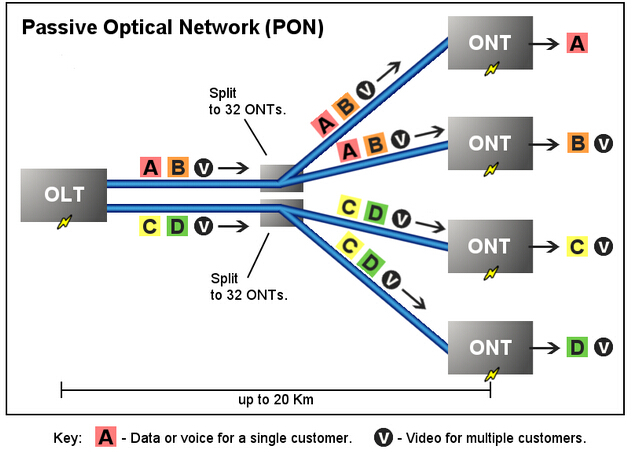With the explosive growth of Internet, the introduction of a broadband access network based on fiber-to-the-office (FTTO) and fiber-to-the-home (FTTH) has been triggered. Under this circumstance, access and metro networks should be scalable in terms of capacity and accommodation as well as flexible with regard to physical topology. Passive optical network (PON), one class of fiber access system, can deal with the various demands.
A passive optical network (PON) is a telecommunication network that uses point-to-multipoint fiber to the end-points in which unpowered optical splitters are used to enable a single optical fiber to serve multiple end-points. It consists of an optical line terminal (OLT) at the service provider’s central office and a number of optical network units (ONUs) or optical network terminals (ONTs), near end users (see the figure below). PON takes advantages of wavelength division multiplexing (WDM) and uses one optical wavelength for upstream traffic while another for downstream traffic on a single-mode fiber. The upstream signals are combined at the splitters by using a multiple access protocol (time division multiple access). The downstream signals are directed to multiple users by using passive optical splitter technology.

Signals in a shared fiber architecture can be split out using two methods. One is active Ethernet (AE), with which the individual signals are split out using electronic equipment near the subscriber. The other one is PON, in which the signals are replicated passively by the splitter. Compared with AE, a network based on a PON system is more superior. The advantages of PON are as below.
PON incurs lower capital expenditures because it has no electronic components in the field. Also PON lowers the operational expenditures as there is no need for the operators to provide and monitor electrical power in the field or maintain backup batteries. Besides, a PON has a higher reliability because in the PON outside plant there are no electronic components which are prone to failure. Additionally, one of the most crucial features of a PON-based access network is its signal rate and format transparency. It is much simpler for a PON to upgrade to higher bit rates. Both AE and PON require upgraded electronics in the central office (CO) and customer premises, but unlike AE, PON does not need to upgrade in the outside plant as the passive splitters are agnostic to PON speed. Lastly, a PON solution has the ability to span long distances without degrading performance. The low-loss characteristics of single-mode fiber enable PON to support a maximum physical reach of 20 kilometers.
There are some applications for which PON is well suited, such as fiber-to-the-home (FTTH) delivery of voice, Internet data, and cable access broadband video. More specifically, PON is used when the applications require anticipated system to upgrade to high-security areas or where the rerouting of cable may be difficult. Or in the cases that installations involving widely dispersed nodes require long runs of fiber. And PON is utilized for the projects where costs, especially initial deployment costs, are a key concern. At the same time, using PON can help user bandwidth to be adequately managed.
By reading the above illustration, have you got a basic understanding about the passive optical network? Fiberstore, a professional manufacturer and supplier in the optical industry, has many high-quality PON products including PON splitters, optical network units and optical line terminal. Choosing a PON product in Fiberstore can help to deploy your network more efficiently.
